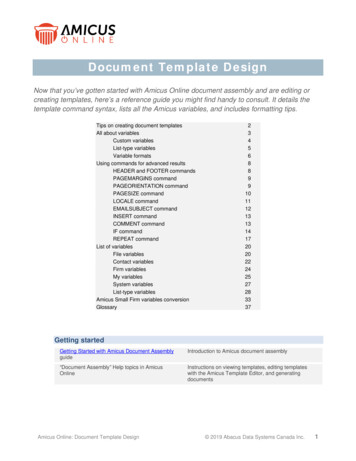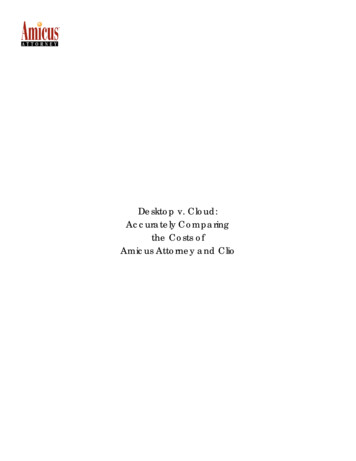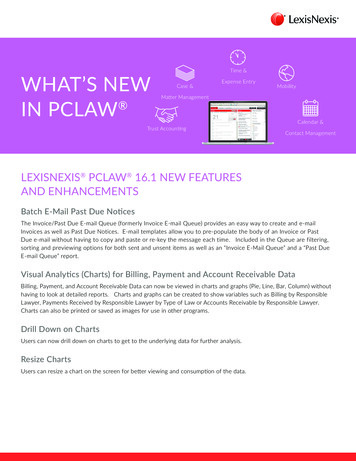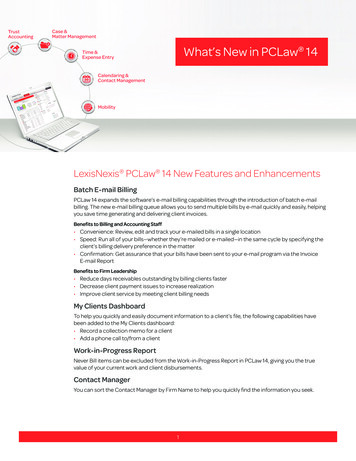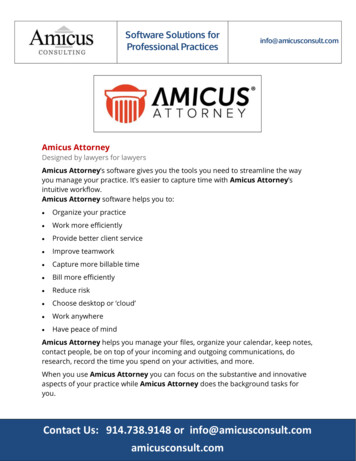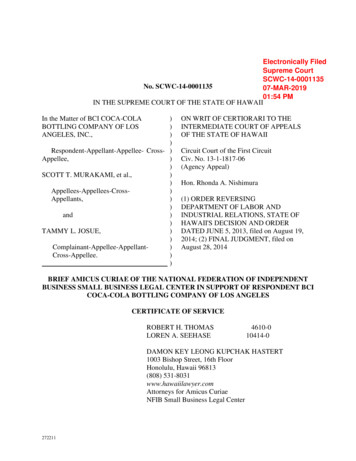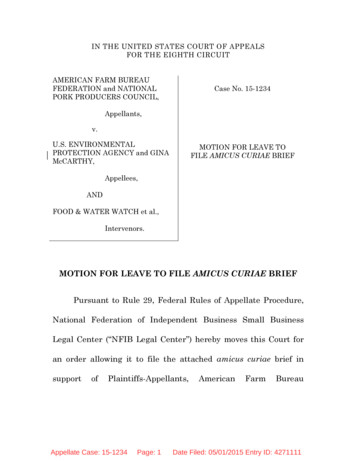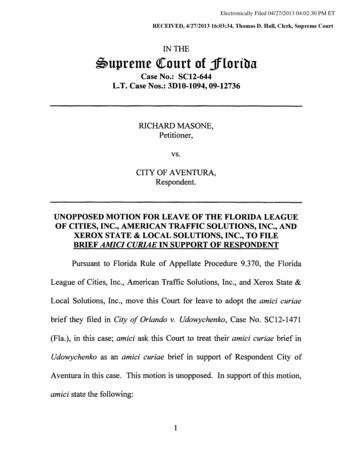
Transcription
Electronically Filed 04/27/2013 04:02:30 PM ETRECEIVED, 4/27/2013 16:03:34, Thomas D. Hall, Clerk, Supreme CourtIN THE u err e Du t of , 'YDrib cCase No.: SC12-644L.T. Case Nos.: 3D10-1094,09-12736RICHARD MASONS,Petitioner,vs.CITY OF AVENTURA,Respondent.UNOPPOSED MOTION FOR LEAVE OF THE FLORIDA LEAGUEOF CITIES,INC., AMERICAN TRAFFIC SOLUTIONS,INC., ANDXEROX STATE &LOCAL SOLUTIONS,INC.,TO FILEBRIEF AMICI CURIAE IN SUPPORT OF RESPONDENTPursuant to Florida Rule of Appellate Procedure 9.370, the FloridaLeague of Cities, Inc., American Traffic Solutions, Inc., and Xerox State &Local Solutions, Inc., move this Court for leave to adopt the amici curiaebrief they filed in City of Orlando v. Udowychenko, Case No. SC12-1471(Fla.), in this case; amici ask this Court to treat their amici curiae brief inUdowychenko as an amici curiae brief in support of Respondent City ofAventura in this case. This motion is unopposed. In support of this motion,amici state the following:1
Background1.In City ofOrlando v. Udowychenko,98 So. 3d 589,599(Fla.5th DCA 2012),the Fifth District Court of Appeal certified conflict with theThird District Court of Appeal's decision in this case, City ofAventura v.Nlasone, 89 So. 3d 233(Fla. 3d DCA 2011), and concluded as follows as tothe intersection safety camera program at issue:The conclusion that local enforcement of trafficsignal violations by cameras are preempted bystate law admittedly conflicts with City ofAventuYa. In that case,the majority concluded thatthe city's red light camera program "falls squarelywithin the specific authority carved out in section316.008(1)(w) by the Florida legislature." City ofAventura, 89 So. 3d at 239. However, the state'sauthorization to municipalities to regulate traffic insection 316.008(1)(w)appears to contemplate onlyunique situations for which a statewide law islacking or is inadequate. Here the Legislature hasmandated that drivers stop at red light signals andhas provided the mechanism to enforce thatmandate. The imposition ofseparate and additionalpenalties for running a red light in a particularmunicipality does not fall within the specificauthority ofsection 316.008(1)(w).98 So.3d at 599.2.case.This Court has granted review in both Udowychenko and thisThe Court granted amici leave to file an amici curiae brief inUdowychenko on January 22, 2013. (Order granting leave attached asExhibit A.) Amici timely filed their amici curiae brief in Udowychenko on a
January 25, 2013. (Udowychenko amici curiae brief of the Florida Leagueof Cities, Inc., American Traffic Solutions, Inc., and Xerox State &LocalSolutions, Inc. and its appendix attached as Exhibits B & C). Althoughamici urge approval in Masone and quashal in Udowychenko, the substanceoftheir briefapplies equally to both cases.Statement ofInterests3.The Florida League of Cities(the "League")is the united voicefor Florida's municipal governments. Its goals are to serve the needs ofFlorida's cities and promote local self-government. The League was foundedon the belief that local self-government is the keystone of Americandemocracy.4.The League has a special interest in this case due to its potentialimpact on the ability of Florida municipalities to institute and administerpublic safety programs, such as intersection safety camera programs,pursuant to their constitutional and statutory home rule authority and policepowers.5.American Traffic Solutions, Inc.("ATS"),and Xerox State andLocal Solutions, Inc. ("Xerox"), formerly known as ACS State &LocalSolutions, Inc., are providers oftechnology and business solutions for phototraffic safety programs in Florida. With respect to intersection safety camera3
programs like those at issue in this appeal, Xerox and ATS provide localgovernments and other governmental entities with intersection safetycameras, vehicle sensors, and other equipment and processes to capture avideo recording and photographic images of motor vehicles involved in redlight violations. The video and photographic evidence is reviewed by localauthorities responsible for enforcing applicable laws and ordinances, whodecide whether a violation of applicable law or ordinance has occurred andshould be enforced.5.ATS's customers include more than 200 government agencies.It has installed nearly 2,200 intersection safety cameras throughout thecountry, with hundreds more in various stages of planning. ATS alsocurrently serves more than 50 local governments throughout the state ofFlorida.6.Xerox has five programs in Florida and, over the past decade,Xerox has operated over 30 contracts with government agencies in 14 stateswith more than 500 cameras installed and operated.7.Amici are able to offer the Court assistance and differentperspectives related to the same issues briefed by the parties. !
Consultation8.Undersigned counsel for amici has consulted with counsel forthe City of Aventura, Edward G. Guedes, and counsel for Mr. Masone,Andrew Harris,and has been advised that neither opposes this motion.WHEREFORE, Amici Curiae, the Florida League of Cities, Inc.,American Traffic Solutions, Inc., and Xerox State &Local Solutions, Inc.,respectfully move this Court for leave to adopt the amid curiae brief theyfiled in City ofOrlando v. Udowychenko,Case No.SC12-1471 (Fla.),in thiscase; Amici ask this Court to treat their amid curiae brief in Udowychenkoas an amid curiae brief in support of Respondent City of Aventura in thiscase, with the understanding that amid urge approval in Masone and quashalin Udowychenko.5
Respectfully Submitted,/s/Joseph Ha edorn Lang,Jr.Samuel J. Salario, Jr.Florida Bar Number 083460Joseph Hagedorn Lang,Jr.Florida Bar Number 059404Alan RosenthalFlorida Bar Number 220833Jack R.ReiterFlorida Bar Number 028304CARLTON FIELDS,P.A.100 S.E. Second StreetSuite 4200Miami,FL LTON FIELDS,P.A.Corporate Center Threeat International Plaza4221 W.Boy Scout Blvd.,Suite 1000Tampa,FL io@carltonfields.comjLang@carltonfields.comHarry "Chip" Morrison,Jr.Florida Bar Number 339695Florida League of Cities,Inc.301 South Bronough Street,Suite 300Tallahassee,Florida 32302-1757Telephone:(850)222-9684Nancy G.LinnanFlorida Bar Number 182158Carlton Fields,P.A.215 South Monroe StreetSuite 500Tallahassee,FL n@carltonfields.comAttorneys for Amici CuriaeG
CERTIFICATE OF SERVICEI HEREBY CERTIFY that a true and correct copy of the foregoinghas been furnished via e-mail (.pd to: Bard D. Rockenbach, Esq. andAndrew A. Harris, Esq., Burlington & Rockenbach, P.A., 444 W. RailroadAvenue, Suite 430, West Palm Beach,FL 33409 (bdr(a flappellatelaw.com;aah(c r flappellatelaw.com;, (c z pellatelaw.com), and Edward G. Guedes,Weiss Serota Helfman Pastoriza Cole & Boniske, 2525 Ponce de LeonBlvd., Suite 700, Coral Gables, Florida 33134 (EGuedes cr,wsh-law.com),this 27th day ofApril,2013./s/Joseph Hagedorn Lan ,Jam7
u rente court ot, ' oriba TUESDAY,JANUARY 22,2013CASE NO.:SC12-1471Lower Tribunal No(s).: SD11-720,09-CA-26741CITY OF ORLANDO,FLORIDAvs.Petitioners)MICHAEL UDOWYCHENKO,ETC.,ET AL.Respo dent(s)The motion for leave to file briefas amicus curiae filed by The FloridaLeague ofCities,Inc., American Traffic Solutions,Inc.,and Xerox State &LocalSolutions,Inc. are hereby granted and they are allowed to file briefonly in supportofpetitioner. The briefby the above referenced amici curiae shall be served on orbefore January 24,2013.Per this Court's Administrative Order In Re: Mandatory Submission ofElectronic CoQies ofDocuments, AOSC04-84,dated September 13,2004,counselare directed to transmit a copy ofall briefs in an electronic format as required bythe provisions ofthat order.A True CopyTest: ioinas D.HallLlerk,Supreiiie CotutabServed:HON.PAMELA R.MASTERS,CLERKSAM[IEL JOSEPH SALARIO,JR.FREDERICK STANTON WERMUTHJOSEPH HAGEDORN LANG,JR.VINCENT FALCONS,IIITHOMAS ALAN ZEHNDERHARRY MORRISON,JR.CHARLES TALLEY WELLSBARD DArTIEL ROCKENBACHANTHONY ANGELO GARGANESEDAVID B.KINGJACK ROY REITERNANCY G.LINNANALAN ROSENTHALANDREW A.HARRISERIN JANE O'LEARYUSHER LARRY BROWNJASON DREW WEISSERRICHARD E.MITCHELL HIBIT
IN THE u rerr P court of , 'YortbaCase No.: SC12-1471L.T,Case Nos.:5D11-720,09-CA-26741CITY OF ORLANDO,FLORIDA,Petitioner,vs.MICHAEL UDOWYCHENKO,etc.,et al.Respondents.BRIEF AMICICURIAE OF FLORIDA LEAGUE OF CITIES,INC.,AMERICANTRAFFIC SOLUTIONS,INC., AND XEROX STATE&LOCAL SOLUTIONS,INC.,IN SUPPORT OF PETITIONERAlan RosenthalFlorida Bar Number 220833Jack R.ReiterFlorida Bar Number 028304Samuel J. Salario,Jr.Florida Bar Number 083460Joseph Hagedorn Lang,Jr.Florida Bar Number 059404CARLTON FIELDS,P.A.CARLTON FIELDS,P.A.100 S.E. Second StreetSuite 305)530-0055Corporate Center Threeat International Plaza4221 W.Boy Scout Blvd.,Suite 1000Tampa,Florida el list continued on next page)EXHIBIT
Nancy G.LinnanFlorida Bar Number 182158CARLTON FIELDS,P.A.215 South Monroe StreetSuite 500Tallahassee,Florida Chip"Morrison,Jr.Florida Bar Number 339695Florida League ofCities, Inc.301 South Bronough Street,Suite 300Tallahassee, Florida 32302-1757Tel:(850)222-9684Attorneys for Amici Curiaezs saosa.s
TABLE OF CONTENTSPageTABLE OF AUTHORITIES. iiIDENTITY AND INTEREST OF AMICUSCURIAE.1SUMMARY OF ARGUIVIENT.2ARGUMENT .5I.THE INTERSECTION SAFETY CAMERA PROGRAMS AT ISSUEHERE ARE PROPER EXERCISES OF HOME RULE AUTHORITYAND POLICE POWERS.5A.The Scope ofHome Rule Authority.6B.A Municipality's Home Rule Authority to Maintain SafeRoadways is Consistent with General Law.9II.SOCIAL SCIENCE STUDIES DEMONSTRATE THATINTERSECTION SAFETY CAMERA PROGRAMS PROVIDEREAL SAFETY BENEFITS.14III.PUBLIC OPITTION POLLS DEMONSTRATE THAT INTERSECTIONSAFETY CAMERA PROGRAMS ARE FAVORED BY LARGEMAJORIT ES.18CONCLUSION .20
TABLE OF AUTHORITIESCASESAgomo v. Fenty,916 A.2d 181(D.C.2007). 13Carter v. Town ofPalm Beach,237 So.2d 130(Fla. 1970).7City ofAventura v. Masone,89 So. 3d 233(Fla. 2011).7,8,9City ofDavenport v. Seymour,755 N.W.2d 533,535-36(Iowa 2008).2 13 18City ofHallandale Beach v. Smith,853 So.2d 495(Fla.4th DCA 2003).7City ofHollywood v. Mulligan,934 50.2d 1238(Fla.2006).5City ofKissimmee v. Fla. RetailFed'n Inc.,915 So.2d 205(Fla. 5th DCA 2005).9City ofKnoxville v. Brown,284 S.W.3d 330(Tenn.Ct. App.2009).13City ofMiamiBeach v. Rocio Corp.,404 So.2d 1066(Fla.3d DCA 1981).8Ezile v. Miami-Dade35 So. 3d 118(Fla. 3d DCA 2010).9Cnry.,Idris v. City ofChicago,552 F.3d 564(7th Cir. 2009).12, 9]Laborers Int'1 Union ofN. Am., Local 478 v. Burroughs,541 So.2d 1160(Fla. 1989).9'Lowe v. Broward Cnty.,766 So.2d 1199(Fla.4th DCA 2000).9, 13ii
Mendenhall v. City ofAkron,881 N.E.2d 255(Ohio 2Q08).12MiamiShores Village v. Cowart,108 So.2d 468(Fla. 1958).10Qcala v. Nye,608 So.2d 15(Fla. 1992).10Quiles v. City ofBoynton Beach,802 So.2d 397(Fla.4th DCA 2001).6Sarasota Alliance For Fair Elections,Inc. v. Browning,28 So. 3d 880(2010).11Sevin v. Parish ofJefferson,621 F. Supp.2d 372(E.D.La.2009).13State v. Dade County,I42 So.2d 79(Fla. 1962).11CONSTITUTION AND STATUTES§ 166.021(1),Fla. Stat.(1999).5§ 166.021(3)(c),Fla. Stat.(1999).8§ 166.021(4),Fla. Stat.(1999).8§ 316.008 1) b) Fla. Stat.(2009).5Art. VIII,§ 2(b), Fla. Const.5,6iii
OTHER AUTHORITIESFed. Highway Admin., "Safety Evaluation of Red-Light Cameras,"Research, Development, and Technology, Turner-Fairbank HighwayResearch Center(FHWA-HRT-OS-048 April 2005) .17Fla. Dept of Highway Safety and Motor Vehicles, Red Light CameraProgram Analysis(December 28,2012).14-15Richard Danielson, Crashes Drop 29 Percent at Tampa's Red LightCamera Intersections, TAMPA BAY TIMES, Jan. 5, 2013.(Available nts/article1268963.ece). 15Summary ofJanuary 2012 Public Opinion Polls by FrederickPolls.4, 18Synetics Safety Specialists, "Evaluation of the Effectiveness of theCalgary Police Service Red-Light Camera Program," Calgary PoliceService, City ofCalgary(January 2009). 17Troy D. Walden, Ph.D., "Analysis on the Effectiveness ofPhotographic Traffic Signal Enforcement Systems in Texas," CrashAnalysis Program of the Center of Transportation Safety, TexasTransportation Institute, The Texas A&M University System(2009) .15-16iv
IDENTITY AND INTEREST OF AMICICURIAEThe Florida League ofCities(the "League")is the united voice for Florida'smunicipal governments. Its goals are to serve the needs of Florida's cities andpromote local self-government. The League was founded on the belief that localself-government is the keystone ofAmerican democracy.The League has a special interest in this case due to its potential impact onthe ability of Florida municipalities to institute and administer public safetyprograms, such as intersection safety camera programs, pursuant to theirconstitutional and statutory home rule authority and police powers.American Traffic Solutions, Inc. ("ATS") and Xerox State &LocalSolutions, Inc.("Xerox") are providers of technology and business solutions forphoto traffic safety programs in Florida. With respect to intersection safety cameraprograms like those at issue in this appeal, ATS and Xerox provide localgovernments and other governmental entities with intersection safety cameras,vehicle sensors, and other equipment and processes to capture a video recordingand photographic images of motor vehicles involved in red light violations. Thevideo and photographic evidence is reviewed by local authorities responsible forenforcing applicable laws and ordinances, who decide whether a violation ofapplicable law or ordinance has occurred and should be enforced.1
ATS's customers include more than 300 government agencies. It hasinstalled nearly 3,000 intersection safety cameras throughout the country, withhundreds more in various stages of planning. ATS also currently serves more than60 local governments throughout the state of Florida. ATS acquired the stock ofLasercraft, Inc., which is not actively participating in this review proceeding,during the course ofproceedings below. ATS has not participated in the litigationofthis case.Xerox has five programs in Florida and, over the past decade, Xerox hasoperated over 30 contracts with government agencies in 14 states with more than500 cameras installed and operated.Both ATS and Xerox have a global perspective to offer the Court in itsconsideration ofthe issues.SUMMARY OF THE ARGUMENTIntersection safety camera programs like those under review here save livesand conserve the increasingly scarce resources of local governments seeking toimprove public safety. By employing cameras and vehicle sensors, such programsallow local governments to detect red light violations despite the impracticabilityand significant expense of having a live traffic officer at the scene. See Ciry ofDavenport v. Seymour,755 N.W.2d 533,535-36(Iowa 2008).2
Prior to the recent state legislation bringing intersection safety cameraprograms within the ambit ofChapter 316 ofthe Florida Statutes, at least 37 localgovernments in Florida operated such programs pursuant to local ordinances.Local innovation in this field found legal support in the rule that a regularlyenacted ordinance is presumed to be a valid exercise of a municipality's broadhome rule powers, a presumption that is at its zenith when a local governmentlegislates on matters affecting the health, safety, and welfare of its citizens.Approving the Fifth District's decision would contravene that establishedpresumption and stifle both the ability and willingness of local legislatures topursue new programs and new technologies to protect the safety oftheir citizens.The local governments' foresight in exercising their home rule powers toadopt intersection safety camera programs is justified by the empirical research.The studies demonstrate that intersection safety camera programs provide provensafety benefits, consistently finding a decline in right-angle collisions atintersection after intersection where safety cameras were installed. The action ofthose municipalities that adopted ordinances like the one in this case thusdemonstrably made their citizens safer than those of municipalities that did not.That type of safety legislation lies at the heart of the constitutional home rulepower.3
The local governments'use oftheir home rule authority and police powers isalso consonant with the desires oftheir constituents. A 2012 poll of800 registeredvoters in Florida,conducted by FrederickPolls,revealed that 71% ofvoters supportthe use ofthese cameras in their communities to detect red-light runners.The Fifth District's decision should be quashed.4
fARGUMENTI.THE INTERSECTION SAFETY CAMERA PROGRAMS ATISSUEHERE ARE PROPER EXERCISES OFHOME RULE AUTHORITYAND POLICE POWERS.Prior to the recent state legislation bringing intersection safety cameraprograms within the ambit of Chapter 316 of the Florida Statutes, localgovernments (like the City of Orlando in this case) enacted intersection safetycamera programs through ordinances under their very broad home rule authorityand in the exercise of their police powers. See Art. VIII, § 2(b), Fla. Const.;§ 166.021(1),(3)(c),(4),Fla. Stat.(1999); City ofHollywood v. Mulligan,934 So.2d 1238, 1243(Fla. 2006)("In Florida, a municipality is given broad authority toenact ordinances under its municipal home rule powers."). Consistent with theexercise of those powers, Chapter 316 of the State Uniform Traffic Code (as itexisted at the time these ordinances were adopted) did not prevent localgovernments from regulating their streets "by means of police officers or officialtraffic control devices." See § 316.008(1)(b), Fla. Stat. (2009). Indeed, section316.008(1)(w)expressly provided:(1) The provisions of this chapter shall not bedeemed to prevent local authorities, with respect tostreets and highways under their jurisdiction and withinthe reasonable exercise ofthe police power,from:5
(w)Regulating,restricting, or monitoring traffic bysecurity devices or personnel on public streets andhighways,whether by public or private parties.Because the authority for these programs is rooted in municipal home ruleauthority and police powers, the decision in this appeal could have far-reachingeffects by casting doubt upon the legitimacy of statewide intersection safetycamera programs, exposing scores of local governments (and vendors like ATSand Xerox)to protracted disputes and litigation over traffic safety programs that lieat the heart ofthe home rule power.A.The Scope of Home Rule AuthorityThe Florida Constitution gives municipalities broad governmental,corporate, and proprietary powers. See Quiles v. City ofBoynton Beach, 802 So.2d 397, 398 (Fla. 4th DCA 2001); Art. VIII, § 2(b), Fla. Const.; § 166.021, Fla.Stat. ("As provided in s. 2(b), Art. VIII of the State Constitution, municipalitiesshall have the governmental, corporate, and proprietary powers to enable them toconduct municipal government, perform municipal functions, and render municipalservices, and may exercise any power for municipal purposes, except whenexpressly prohibited by law,").Florida courts define the scope of a "municipal purpose" to include a duty"to protect the safety, the health and the general welfare of the citizens." SeeQuiles, 802 So. 2d at 398, 400 (holding a community's home rule authorityD
includes police power to fluoridate its water for the health, safety, and generalwelfare ofthe citizens); see also City ofAventura v. Masone, 89 So. 3d 233, 235(Fla. 2011)("It is well established that Florida law grants municipalities broadhome rule and police powers."),jurisdiction accepted sub nom. Masone v. City ofAventura, No. SC12-644,2012 WL 5991346(Fla. Nov.6,2012); Carter v. TownofPalm Beach, 237 So. 2d 130, 131 (Fla. 1970)("A municipality may, under thepolice power, regulate and restrain activities which threaten the public health,safety and welfare."); see, e.g., Malone,89 So. 3d at 236-37(affirming ordinanceenacted under City's "broad home rule powers in response to concerns thatdrivers.were failing to heed existing traffic control signals" because "the plaintext ofthe Uniform Traffic Control Law expressly confers authority to a municipalgovernment to regulate traffic within its municipal boundaries as a reasonableexercise of its police power where such regulation does not conflict, butsupplements the laws found therein."); City ofHallandale Beach v. Smith,853 So.2d 495, 497-98 (Fla. 4th DCA 2003)(city condemning property inside its citylimits "was permitted to acquire the Church pursuant to its home rule powers tocondemn property located within its boundaries absent an express prohibition").The Legislature respects the sweeping power of municipalities and hasexpressed a legislative purpose"to remove limitations on the exercise ofhome rulepowers" by codifying municipalities' broad home rule powers in the Municipal7
Home Rule Powers Act("Home Rule Powers Act"). See City ofMiami Beach v.Rocio Corp., 404 So. 2d 1066, 1067-68 (Fla. 3d DCA 1981). The Home RulePowers Act includes a provision granting a municipality the authority to enactlocal ordinances that do not conflict with general law. See § 166.021(3)(c), Fla.Stat.; Masone, 89 So. 3d at 235-36.The Home Rule Powers Act alsoacknowledges that municipalities enjoy a sweeping reserve ofpower in the absenceofclear, express legislative or constitutional prohibition:The provisions of this section shall be so construed as to secure formunicipalities the broad exercise of home rule powers granted by theconstitution. It is the further intent of the Legislature to extend tomunicipalities the exercise of powers for municipal governmental,corporate, or proprietary purposes not expressly prohibited by theconstitution, general or special law, or county charter and to removeany limitations, judicially imposed or otherwise, on the exercise ofhome rule powers other than those so expressly prohibited.§ 166.021(4),Fla. Stat.Thus, when a municipality enacts an ordinance in furtherance of its broadhome rule powers,"(a] regularly enacted ordinance will be presumed to be validuntil the contrary is shown,and a party who seeks to overthrow such an ordinancehas the burden of establishing its invalidity." Masone, 89 So. 3d at 236 (internalquotation marks omitted). Where there is no direct conflict between a municipalordinance and a general law, appellate courts will " indulge every reasonablepresumption in favor of an ordinance's constitutionality."' Id. (quoting Ciry of8
Kissimmee v. Fla. Retail Fed'n Inc., 915 So. 2d 205, 209(Fla. 5th DCA 2005));Lowe v. Broward Cnty.,766 So.2d 1199,1203(Fla.4th DCA 2000).B.A Municipality's Home Rule Authority to Maintain SafeRoadways is Consistent with General LawThe extent ofhome rule authority reaches its limits only ifthe subject matterof its ordinance is preempted by state statute, or if its ordinance conflicts with ageneral law. The test of direct conflict between an ordinance and a statute issimilarly constrained. For example,if an ordinance merely offers a more stringentregulation or penalty than a statute, that ordinance does not conflict with thestatute. See, e.g., Laborers'Int'1 UnionofN. Am., Local 478 v. Burroughs, 541So. 2d 1160, 1161 (Fla. 1989)(test of conflict is not met where county ordinanceimposes identical anti-discrimination requirements as the state statute, albeit upona wider and broader class of entities than the statute); Exile v. Miami-Dade Cnty.,35 So. 3d 118, 119(Fla. 3d DCA 2010)(ordinance mandating stricter standard didnot conflict with statute because, by complying with the stricter local ordinance,party would be in compliance with the looser state regulation).It is clear that the Uniform Traffic Control Law does not preempt amunicipality's power to control and regulate traffic through red light camerasbecause the statute expressly contemplates a municipality's authority to use suchmeasures.As the Masone Court correctly noted, the statute specificallycontemplates the use of such devices, whether provided by public or privateE
parties, and "[t]he City is in a unique position to identify dangerous intersectionswithin its boundaries and implement additional safeguards to prevent accidents atsuch intersections." 89 So. 3d at 237. Furthermore, even in the absence of anexpress grant ofauthority by the Legislature, a municipality retains the authority toexercise its home rule powers. Legislative enactments serve merely to expressparameters regarding existing home rule powers. "Thus, municipalities are notdependent upon the legislature for further authorization, and legislative statutes arerelevant only to determine limitations of authority. Although section 166.401,Florida Statutes (1989), purports to authorize municipalities to exercise eminentdomain powers, municipalities could exercise those powers for a valid municipalpurpose without any such grant' of authority." Ocala v. Nye, 608 So. 2d 15, 17(Fla. 1992)(footnote omitted).Maintaining the safety of residents upon public roadways is entirelyconsistent with home rule authority recognized within the Florida Constitution toprotect safety and welfare ofcitizens. In MiamiShores Village v. Cowart, 108 So.2d 468, 472 (Fla. 1958), this Court considered whether home rule authorityallowed Dade County to establish uniform traffic control and enforcementthroughout the metropolitan area. This Court concluded that traffic control andenforcement was "in accord with the intent and purpose of the constitutionalauthority granted by the Home Rule Amendment." Id. This Court relied upon its10
decision in Cowart in State v. Dade County, 142 So. 2d 79,85(Fla. 1962), when itconcluded that the purchase and operation of a county-wide transit system inconnection with the development of public services and utilities was"[o]ne oftheobvious purposes ofmetropolitan government."Moreover, because public services and transportation is an obvious purposeoflocal government, it cannot be said that the municipalities are preempted by anystate action or legislation on red light cameras as they pertain to trafficenforcement.Preemption is implied when the legislative scheme is sopervasive as to evidence an intent to preempt theparticular area, and where strong public policy reasonsexist for finding such an area to be preempted by theLegislature. Implied preemption is found where thestate legislative scheme ofregulation is pervasive and thelocal legislation would present the danger ofconflict withthat pervasive regulatory scheme.Sarasota Alliance For Fair Elections, Inc.Browning,28 So.3d 880,886(2010)v.(internal citations and quotation marks omitted). "Florida courts have not found animplied preemption oflocal ordinances which address local issues." Id. at 887. Soit is here. The municipality's interest in addressing traffic—a uniquely localconcern—is not preempted by legislation concerning r
Apr 27, 2013 · cameras, vehicle sensors, and other equipment and processes to capture a video recording and photographic images ofmotor vehicles involved in red light violations. The video and photographic evidence is reviewed by local authorities resp


